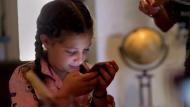"Generation Zapped"
"The system is broken with regard to protecting consumers from wireless signals."
"Studies around the world have clearly shown that it is the nonthermal, indirect effects that are of most concern today."
"The industry responds to what people want in their gadgets: more data, faster downloads, more pixels. But there is not an incentive toward changing the signal forms, for example, so that these biological cascades are not triggered."
George Carlo, industry scientist, critic, wireless technology
"It's like the tobacco, chemical, or pharmaceutical industries. They tell us this stuff is safe, and then, decades later, you find out that they were hiding all this evidence that it was causing us harm."
"It's an accomplishment for me [that "Generation Zapped" was featured at the Silicon Valley International Film Festival for Google employees], because the movie is showing right where the technology is invented."
"These are the guys who can make the difference."
"I made the movie because no one would believe me. But that's the power of media. When it's well done, well documented, and doesn't go into conspiracy theories or fake news, then people listen to the information and are willing to make lifestyle changes for the health of their family."
"Netflix, for instance, they do streaming, so they're not going to show this film because of the nature of their business."
Sabine El Gemayel, filmmaker
 |
| "Generation Zapped" Still from Trailer |
The revelatory film that resulted when El Gemayel felt it was past time for the purported harm produced by wireless systems on the public, features scientists discussing the dangers inherent in wireless exposure. Also featured are people whose claims of having become ill from that exposure support what the scientists claim. The story of a powerful wireless industry shaping public policy to ensure their devices and the field powering them receive little scrutiny or government oversight is the message in full.
In 2015, the National Toxicology Program of the U.S. released a report resulting from its 16-year. $25-million examination of the health impacts of wireless radiation. According to the researchers involved, the microwave field emanating from cellphones is "proven to be harmful to humans and the environment". Those harmful effects encompass the increased risk of cancer, a rise in harmful free radicals, genetic damage, structural and functional alterations in our reproductive system, neurological disorders along with learning and memory deficits; and finally a totally negative effect on general well-being.
Unsurprisingly, the 4.8-billion cellphones currently in use worldwide functioning through wireless radiation is such a commonplace that we rarely give a thought to possible consequences of flooding the atmosphere and ourselves heedlessly with radiating effects. We have received assurances since the 1990s through industry announcements, augmented by governmental validation, that there are no studies revealing any problems that might be associated with wireless exposure.
 |
| Our bodies are subjected to one quintillion (1,000,000,000,000,000,000) times more electromagnetic radiation compared to just a decade ago, according to Olle Johansson, associate professor in neuroscience at the Karolinska Institute in Sweden.(jamesteohart/shutterstock) |
Public health officials in much of the developed world where authorities in the sphere of public health are in possession of evidence of harm have, on the other hand, taken the issue seriously for years; where in the United Kingdom, France, Belgium, Russia -- among other countries -- children in particular are urged to make minimum use of wireless devices. In 2014, the Centers for Disease Control in the United States issued a reluctant public statement recommending cellphone use caution, yet retracted it a mere few weeks later.
The California Department of Public Health released consumer guidelines on how best to manage exposure to wireless radiation, in particular for children, citing the possibility of a link to conditions such as cancer and low sperm count. Although the CDPH produced their recommendation years ago it was not made public until recently, when a lawsuit forced the agency to alert the public. Industry scientist George Carlo headed a $27-million research project in the 1990s funded by the cellphone industry.
His research results failed to support the goal of the industry to give it a clean bill of health so it could continue to assure the public its technology wasn't harmful. When Dr. Carlo's team discovered a correlation between cellphone emissions and DNA damage, along with a slightly higher rate of brain tumours in those habituated to the use of cellphones compared to non users, the industry dismissed his findings and initiated a campaign to discredit his findings and his scientific expertise.
Through a band of frequencies known as microwaves, communication is accomplished in the manner that we recognize as wireless technology. There is general agreement among most scientists that microwave with its tiny wavelengths has the capacity to damage human biology; how much exposure is required to cause illness is the unknown factor. The assumption is that only microwaves sufficiently intense to cause a thermal reaction; the production of heat, as in a microwave oven; can be considered harmful.
Wireless radiation remits below the thermal threshold, enabled officials to automatically consider these frequencies to be in a safe realm. That consideration, in turn, resulted in cellphones never having been subjected to testing for radiation effects prior to market distribution. There are now roughly a hundred scientific reviews indicating that microwave exposure at non-thermal levels cause deleterious health effects, however.
 |
| In the United Kingdom, France, Belgium, Russia, and other nations, wireless users, especially children, are urged to minimize their exposure to microwave radiation. (Subbotina Anna/Shutterstock) |
Olle Johansson, associate professor in neuroscience at the Karolinska Institute in Sweden, points out that humans are subjected to one quintillion times more electromagnetic radiation today compared to a mere decade earlier. The leading question among those who fail to support the need for caution is that if that radiation is so prevalent how can it be explained that there is no avalanche of symptoms among newly-discovered radiation sufferers? Proof of health problems related to wireless technology is abundant everywhere, but most doctors cannot recognize the signs, according to the advocacy group We are the Evidence.
The World Health Organization has formally recognized the controversial condition called electromagnetic hypersensitivity (EHS), since 2005, noting that measuring how widespread this condition is, presents a problem. EHS is characterized through a wide number of nonspecific physical and dermatological symptoms including headaches, fatigue, skin rashes or burning sensations. All of which symptoms are common enough to be attributed to other causes. In France, a woman succeeded in her 2015 lawsuit for disability benefits related to her EHS.
"Generation Zapped" makes a number of simple recommendations for simple enough habits we can develop which would reduce our exposure to microwave radiation. Turning a cellphone to airplane mode when not in use, for example, or taking the precautionary measure before turning in for the night of turning off one's Wi-Fi router. We do not, the film emphasizes, need to allow ourselves to be washed in microwave radiation every hour of every day.
 |
Labels: Bioscience, Health, Technology

0 Comments:
Post a Comment
<< Home